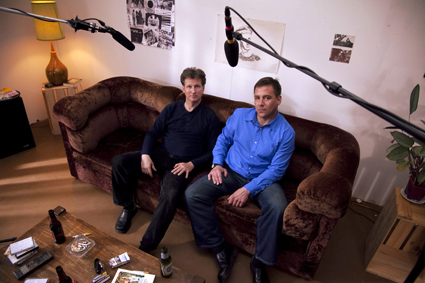 |
Eddie Guerriero, Mitchell Deprey, Shut Up Little Man!, photo Nick Matthews |
Moving into a block of flats “made out of snot and cardboard” (dubbed the “Pepto Bismol Palace,” its sickly pink colour resembling that of the antacid medication), their enthusiasm was soon shattered as they encountered the pair of old men living in the apartment immediately adjacent, Raymond Huffman and Peter Haskett, whose expletive-laden exchanges provoked terror and sleeplessness for the callow Eddie and Mitch.
Spending their days guzzling cheap vodka and unleashing foul-mouthed vitriol upon one another, Huffman and Haskett provided the youngsters’ first experience of life for the long-term unemployed, their fear spurring them to begin recording the abusive sparring reverberating through the walls. The young guys’ motivations shifted however as it became apparent that the torrents of abuse from Peter (a floridly camp gay man) and Ray (a caustically belligerent homophobe) resembled more the mundane squabbling of an old married couple than the precursor to any real violence. They became obsessed, making cassette tapes and distributing them amongst friends who soon disseminated them across the United States where they rapidly developed a cult following.
South Australian Matthew Bate’s documentary Shut Up Little Man! (named for Peter’s trademark dismissal of his roommate) explores the resulting influence that Eddie and Mitch’s recordings have had in American pop culture as well the ethical dilemmas that arise from such use of furtively obtained material. Bate has assembled a slickly produced combination of interviews with primary participants (including Mitch and Eddie, as well as Peter and Ray’s occasional third housemate Tony Newton), interviews with artists who subsequently created work inspired by the recordings, archival footage, re-enactments of Peter and Ray’s antics, as well as excerpts from the recordings themselves.
Whether or not one finds the material humorous—and the appeal is pretty juvenile—the fact remains that many have, the recordings receiving an extended life as a pre-internet example of the ‘viral’ pop-culture phenomenon. Copied and passed on individually through the pre-digital American Tape Traders Network, they were released commercially by the underground magazine Bananafish in 1992. Ray and Peter’s rambling cries of “If you wanna talk to me then shut your fucking mouth!” and “I am the human race you fucking queer!” have been subsequently incorporated into the work of artists as diverse as Daniel Clowes, creator of the Ghost World graphic novel, film director Mike Mitchell, who made Jim Henson-style puppets with which to dramatise the recordings, and surrealist post-punk icons Devo’s side-project The Wipeouters who wrote a song incorporating snippets of the pair’s ranting, a strategy also utilised by New York avant-garde composer John Zorn.
Although the idea is not raised by Bate, in this way the recordings amount to a cultural ‘meme,’ a term coined by Richard Dawkins in The Selfish Gene that “conveys the idea of a unit of cultural transmission, or a unit of imitation.” However, such a conception is somewhat complicated by Mitch and Eddie’s decision to copyright the material after the success of playwright Gregg Gibbs’ 1993 comic drama Shut Up! Little Man, leading to acrimony during the mid-90s as three separate film projects vied for exclusive use of the recordings. Putting aside the question of whether it is even possible to copyright audio verité (defined by the filmmakers during the title sequence as “a term used to describe real-life recordings made surreptitiously: found sounds and phone pranks”), there remains the problem of Ray and Peter’s invaded privacy and whether the artistic use to which their lives have been put amounts to an acceptable tradeoff.
Though certainly diverting, it’s difficult to escape the sense that Bate has paid the subject matter far more attention than it really warrants—something aimed at a television slot might have been more appropriate. Nor do the filmmakers ever adequately address the issue of class that lurks uncomfortably in the background. Have Mitch, now a life insurance salesman, and Eddie, a rare and used book dealer, been merely middle-class voyeurs, able to return to a comfortable suburban existence while Huffman and Haskell succumb to diseases stemming from their chronic alcoholism in the mid 90s? Bates leaves this unexamined, instead focusing on a universalising ‘human element’ that elides the broader economic and social forces that have led to the pair’s degradation. Are the recordings exploitative? Almost certainly. But as Eddie comments in the additional interview material, “If there’s exploitation, then the filmmakers are complicit in that.” And, so by extension, is the audience.
Shut Up Little Man!, An Audio Misadventure premiered at the 2011 Sundance Film Festival and was officially selected for the Edinburgh, Adelaide, Melbourne and other international film festivals.
Shut Up Little Man!, An Audio Misadventure, director Matthew Bate, producers Sophie Hyde, Matthew Bate, cinematography Bryan Mason, music Jonny Elk Walsh, Closer Productions. 87 minutes. The DVD is produced by Madman Entertainment.
RealTime issue #107 Feb-March 2012 pg. 23
© Oliver Downes; for permission to reproduce apply to [email protected]








 back
back